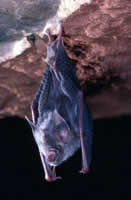Northern leaf-nosed bat

Common name: northern leaf-nosed bat
Scientific name: Hipposideros stenotis
Family: Hipposideridae
Conservation status: This species is listed as Vulnerable in Queensland (Nature Conservation Act 1992).
Description: The northern leaf-nosed bat is a type of micro bat, and weighs 4.6–6.4 g. It has long fur that is grey-brown in colour and is lighter on its belly. The northern leaf-nosed bat is similar in appearance to Semon's leaf-nosed bat, with narrow, pointed ears, and two wart-like projections on the nose-leaf. However, the northern leaf-nosed bat can be distinguished from Semon's leaf-nosed bat by its smaller size, less prominent nose-leaf, and smaller nose-leaf projections.
Habitat and distribution
The only records of northern leaf-nosed bat in Queensland are from Mount Isa. It also occurs in the top end of the Northern Territory and in the western Kimberley of Western Australia.
The northern leaf-nosed bat forages in tall open forest, open eucalypt woodland, flood plains and spinifex hills. Its habitat use and distribution is influenced by the availability of roost sites, as it only roosts in sandstone caves, boulder piles, and disused mines.
Life history and behaviour
As with most micro bats, the northern leaf-nosed bat is nocturnal. It feeds on flying insects that are taken low down among shrubby vegetation, and its flight is slow and butterfly-like. It is not easily disturbed when roosting, even when intruders approach to within 50 cm.
Females give birth to a single young between October and January.
Threatening processes
The known threats to the northern leaf-nosed bat are the destruction and disturbance of roosts. For example, if old mines have become occupied by bats, the reworking of these mines may disturb the bat colonies. This has occurred on Koolan Island and in the Pine Creek area (Northern Territory).
Inappropriate fire regimes and predation by feral cats have also been identified as potential threats.
Recovery actions
- Protect known roosts from disturbance and destruction.
- Implement field surveys to estimate population size.
- Determine the species range through field surveys and checking the identification of specimens from Mount Isa.
Related information
Churchill, S. 2009. Australian Bats (second edition), Allen and Unwin, Sydney.
Curtis, L, Dennis, A, McDonald, KR, Kyne, PM and Debus, SJS. 2012. Queensland’s Threatened Animals. CSIRO Publishing, Collingwood, Victoria
Menkhorst, PW and Knight, F. 2001. A field guide to the mammals of Australia. Oxford University Press, South Melbourne.
Woinarski, J, Burbidge, A and Harrison, P. 2014. The Action Plan for Australian Mammals 2012, CSIRO Publishing, Collingwood.


